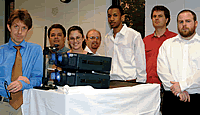2006 Campus Technology Innovators: 3D

TECHNOLOGY AREA: 3D
Innovator: Darton College

OSTRANDER (LEFT) AND HIS TEAM:
Finding ways to think outside of the box
while using off-the-shelf technology.
Challenge Met
Administrators at Darton College (GA), a two-year
institution in the University System of
Georgia, wanted to take study materials in
their Cardiovascular Technology and Anatomy
& Physiology programs out of the lab environment—
and bring them to life for students.
They found their inspiration in 3D stereoscopy
(which creates the illusion of depth by presenting
a slightly different image to each eye,
viewed through polarized glasses).
“I’m always seeking ways of improving
teaching and learning with technology,” says
Darryn Ostrander, director of instructional
technology and distance learning at the
school. “No one else was really using 3D
technology in the classroom, so we decided
to be the first. It seemed natural to apply 3D
to the study of anatomy and physiology.”
By integrating modern 3D rendering programs
with stereoscopic techniques, the Darton
3D Project portrays virtual objects in
three-dimensional space; some models are
still images, others incorporate full-motion
animation and integrated multimedia. Ostrander
notes that the school can make as many
copies of the digital models as necessary,
which means that students are no longer limited
to one set of traditional anatomical models
in a study lab. “The models are easier and
more interesting to study,” he says, “thus
improving student success.”
How They Did It
Ostrander realized that a system of 3D
model development and projection could
be developed using off-the-shelf technology,
and aimed to build a repository of 3D
learning objects using as few proprietary
sources as possible. His team started
exploring and developing a dual projection
system using polarized lenses, and simultaneously
developed stereoscopic 3D models
with Autodesk’s rendering
software, 3D Studio Max.
The team worked with faculty to select a
heart model for development as their first 3D
learning object. Starting with a CAD drawing
of the heart purchased from Zygote Media
Group, the school’s technicians
created an animated 3D stereoscopic
image that literally projects from the video
screen. They added audio of actual heart
valve sounds, carefully synchronized with the
opening and closing of the valves in the animation.
Faculty and students in preliminary
focus groups were amazed, says Ostrander.
Darton initially deployed the 3D projection
system on a mobile cart, comprising a standard
PC, dual-monitor video card, two projectors,
polarizing lenses, non-depolarizing
screen, and 3D glasses. “We are finding
ways to think outside of the box while using
off-the-shelf technology to discover previously
unexplored potential,” says Ostrander.
This fall, the college will advance to full
implementation, with a ceiling-mounted
projection system in a classroom dedicated
to 3D instruction.
Next Steps
Next up: completing 3D stereoscopic presentations
of the rest of the human body. Says
Ostrander, “We are envisioning a Fantastic-
Voyage-type presentation through various
human organs and blood vessels.” He also
notes that the implications of 3D are endless
for anyone who needs to better understand
spatial relationships in three dimensions.
Beyond this, the college plans to unveil a
3D distance learning program; Ostrander’s
team is exploring anaglyph technology
(which utilizes the red and cyan glasses one
often associates with 3D viewing) as an
online delivery model.
Advice
At the outset, Ostrander and his team started
small.“We selected a 3D project that was
within our scope,” he says, “taking stereoscopic
images of real-life objects and models—
not exceedingly difficult.” As they
gained experience, they moved on to more
complex work with stereoscopic video, ultimately
producing 3D images from virtualreality
video objects. The key, says Ostrander:
Take it one step at a time.